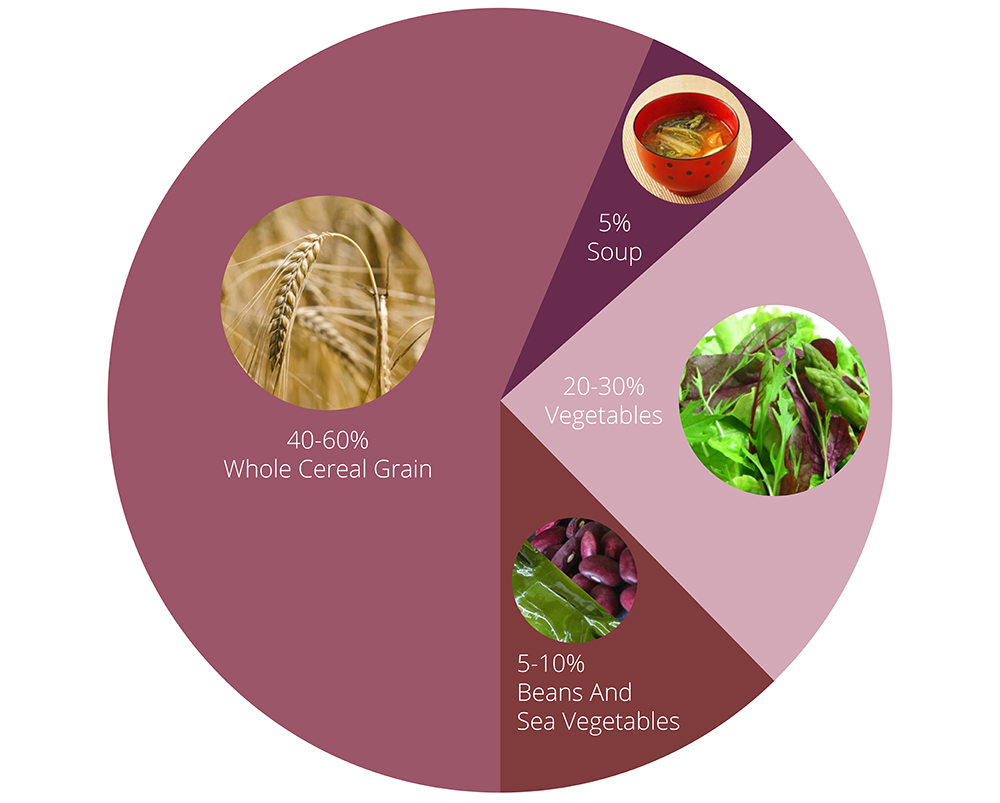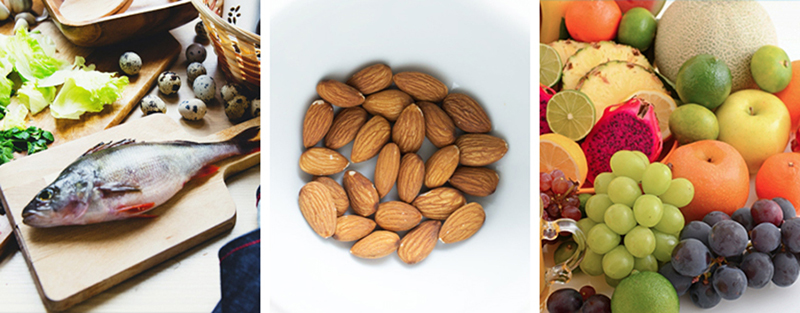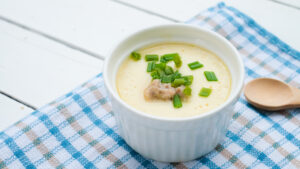Macrobiotic is more than just a diet, it’s a way of life. In addition to dietary restrictions, it also emphasizes on the balance of physical and mental health. The diet is a great alternative for the modern high-fat, hypercaloric, low nutrition diet, and can be a great way to prevent health problems. So, what is it and what kind of food should you eat during the diet?
 Content List
Content List
- Macrobiotic Diet
- What To Eat When You’re On A Macrobiotic Diet
- Daily Foods
- Weekly Foods
- Monthly Foods
- The Reason Why Brown Rice Is The Main Macrobiotic Food
- Macrobiotic Lifestyle Guidelines
- Health Benefits of Macrobiotic Diet
- The Nutritional Value of Macrobiotic Foods
- Original Macrobiotic Diet vs The Current Practice
- Macrobiotic Recipes
- Frequently Asked Questions
- Recommended Macrobiotic Products
Macrobiotic Diet

Macrobiotic diet is a high fiber, high complex carbohydrates, low fat, and mainly vegetarian diet. The diet was founded by George Ohsawa during the early 20th century and created with a set of philosophical mindset to promote a long and healthy living.
The purpose of the diet is not only to eat healthy food, but also to keep the balance of your life. To diligently follow the diet, one must also make a few lifestyle changes. There are a lot of lifestyle guidelines in macrobiotic diet that mainly promote physical and mental health in order to live a long life. Philosophical approach aside, macrobiotic diet itself can be adjusted according to each individual.
Studies have shown that macrobiotic diet can lower serum lipid levels and blood pressure. It can be a preventive strategy for cardiovascular disease. Some would say that macrobiotic diet is a great approach for cancer prevention. But whether or not this diet can be a treatment for cancer itself is still debatable.
This diet might be a great choice if you want to eat healthier or lose some extra weight. However, some studies suggest that macrobiotic diet tend to be hypocaloric and therefore might not be suitable especially for small children and pregnant women.

What To Eat When You’re On A Macrobiotic Diet
This is the standard general guideline of macrobiotic food. The food that you’re preparing should be organic, so avoid genetically modified products and try to choose naturally processed food as much as possible.
The suggestion may require adjustments depending on your health, climate, and other individual considerations. We must be aware that each person has different dietary needs. The dietary needs of children will differ from adults, people with an active lifestyle will have different dietary needs compared to people with a sedentary lifestyle. Personal health plays a big role when following the macrobiotic guidelines. In serious health cases, you should always consult with your doctor or nutritionist first before practicing the diet.

The above chart shows the food percentage for daily intake. The macrobiotic diet also allows supplementary foods to be eaten 2-3 times a week such as local fruits, fish and seafood, nuts, condiments, and beverages.
Daily Foods
Whole Cereal Grain
40-60 percent of a macrobiotic meal must contain whole cereal grains. It can be prepared however you want in a variety of ways. The whole cereal grain that is recommended for regular use are short and medium grained brown rice, barley, buckwheat, corn, rye, whole oats, millet, whole wheat berries, and other whole grains.
For optimal health, only eat these grains occasionally :Long grained brown rice, couscous, mochi, rolled oats, sweet brown rice, noodles, whole rye or whole wheat bread, and other whole grain products.

Vegetables
20-30 percent of the daily intake must contain organic vegetables. The vegetables can be boiled, sauteed, or prepared as a raw salad. Just make sure to avoid oily dressing and mayonnaise for the salad.
Most vegetables are recommended for daily intake. Especially the ones with high fiber and vitamins like most leafy greens vegetables, broccoli, cauliflower, root vegetables, onions, or whatever fresh vegetable is in season.
For optimal nutrition, avoid frequent consumption of potatoes, tomatoes, eggplants, avocado, asparagus, spinach, beets, and zucchini.

Soup
Since macrobiotic diet originated in Japan, it is no surprise that soup became part of the diet. In Japan it is very common to eat with soup, specifically miso soup, on the side. In the macrobiotic guideline, soup covers for 5 percent of the total meal.
Soup is recommended to be consumed about one or two cups per day with moderate natural seasoning like miso, tamari soy sauce, sea salt, umeboshi plum, or ginger.
Recommended soups for macrobiotic diets are beans and vegetable soups, pureed squash or pureed vegetable soups, grain soups, and vegetable soups. For better taste, you can also add sea vegetables, noodles, tempeh, tofu, or occasional white meat to the soup.

Beans And Vegetables
The daily intake of macrobiotic food also contains about 5 to 10 percent of beans and sea vegetables.
Recommended beans for regular consumption includes red beans, black soybeans, chickpeas, lentils, tofu, and fermented bean products such as tempeh and natto.
In the case of sea vegetables, daily intake of seaweed, kelp, algae is encouraged. Among all Japanese sea vegetable products, kombu, nori, and wakame is recommended for daily consumption.

Weekly Foods

If you want, supplementary foods can be eaten occasionally once to three times per week.
The foods that are categorized as a supplementary macrobiotic food are local fruits (fruits that can be harvested where you live), white meat fish, natural seasonings, beverages with no processed sugar, seeds, and nuts.
Monthly Foods

They are not prohibited but not recommended for frequent intake. Minimize the consumption of red meat, poultry, eggs, dairy, chemically treated foods, and beverages with artificial sweetener. Limit the intake of these foods as much as you possibly can.
The Reason Why Brown Rice Is The Main Macrobiotic Food
When we talk about the macrobiotic diet, there’s a definite chance that brown rice will be mentioned. The food itself is one of the main ingredients from the original guideline and is still recommended in the modern practice of the macrobiotic diet.
Macrobiotic lifestyle strongly promotes low consumption of animal proteins and high consumption of foods that suit the natural constitution of the human body. Unlike white rice, brown rice is extremely rich in nutrients and can make up the required energy for the day without having to overeat.
From the perspective of macrobiotic philosophy, macrobiotic food should be derived from local harvest and consumed without too much processing. The diet originated in Japan, so it is no wonder that rice products, especially brown rice, became the main food of macrobiotic diet. Brown rice went through less refining process than white rice, making it a lot more dense in nutrition. That is why brown rice is heavily emphasized in the diet.
- Kawashimaya Koso Genmai – Fermented Brown Rice (150gr)
- Koso Genmai, or fermented brown rice, is a delicious yet healthy Japanese food that can be eaten daily especially when you’re on a macrobiotic diet. Koso Genmai is made from brown rice, red beans, black rice, and sea salt.
- Price: $3.83
- View Product
Macrobiotic Lifestyle Guidelines
Other than being mindful over what to eat, the macrobiotic diet also suggests a few lifestyle changes. Some of them are:
・Avoid overeating.
・Avoid eating 3 hours before bedtime.
・Chew your food thoroughly for better digestion.
・You can eat regularly, 2-3 times a day or as much as you need, provided that the proportion is correct.
・If you can, cook the food yourself. By cooking your own food, you’ll have control over what goes in your cooking. It’s cheaper and healthier.
・Use natural cooking utensils.
・Overall, be mindful of physical and mental health to improve the quality of life.
Health Benefits of Macrobiotic Diet
When done properly, macrobiotic diet is a very healthy diet and can have a preventive action on some major diseases. These are some health benefits that you can get from the macrobiotic diet:
Health Benefit 1 Prevent Cardiovascular Disease And Lower The Blood Pressure.

Research reported that men and women who followed macrobiotic diet have lower cardiovascular risk factors than the general population.
Health Benefit 2 Help To Maintain A Healthy Body Weight

With proper rest and exercise, macrobiotic diet can be a healthy way to lose extra weight. Not only for a short term solution, but also for maintaining a healthy weight in the long term.
Health Benefit 3 Reduce The Risk of Diabetes Melitus

Macrobiotic diet consists of high fiber and high complex carbs. This will benefit people with diabetes melitus.
In a research conducted by the Kushi Institute, 13 patients with type 2 diabetes experienced reduction in medications, decreased blood pressure and energy improvement after just one week of macrobiotic diet.
The Nutritional Value of Macrobiotic Food
Energy
Moderate consumption is the main key of macrobiotic diet. Overall, macrobiotic diet is low in energy because it is high in bulk and fiber and low in fat.
If you’re looking for a way to lower your caloric intake, this diet can be a healthy method to do it.
Protein
Protein can be obtained from legumes. When consumed together with rice and plant protein, the biological value of the protein is sufficient.
Combinations of nuts, legumes, and grains in macrobiotic diet compliment each other and can provide sufficient amino acids when eaten enough.
Consuming a variety of plant protein in sufficient amounts is good to provide energy.
Low In Fat And Cholesterol
It’s true that the macrobiotic diet is low in fat percentage (especially saturated fat) and can lower the risk of coronary artery disease.
Important fatty acid can be obtained from seeds, nuts, grain, leafy green veggies, and fish.
Carbohydrate And Fiber
As we know, macrobiotic diet is very high in dietary fiber especially from veggies, whole grain products, and legumes.
Refined sugar is usually avoided, but fermented carbohydrates like sugars from fruits and starches are allowed. Lowering the risk of dental cavities.
Vitamins
Macrobiotic diet might not be the best approach for infants and children because they need high amounts of Vitamin B12 and Vitamin D. These vitamins are often found in animal-derived foods. Macrobiotic diet limit the intake of these kinds of food.
Minerals
Dairy food that is rich in calcium is rarely consumed in a macrobiotic diet. Therefore calcium intake is mainly from kale, collards, dried peas, beans, and bony fish.
Macrobiotic diet also limit red meat which is rich in iron. You can replace it by consuming peas, beans, and foods that are fortified with iron.
And as for zinc, you can get it from fermented soy foods like tempeh, miso and sprouted legumes. Zinc from these foods are easier to absorb than unfermented soy products like soymilk and tofu.
Original Macrobiotic Diet vs The Current Practice
The original practice of macrobiotic diet itself was quite rigid. When George Ohsawa first introduced it, the diet avoided all animal products. It is very different from what is practiced in the modern days.
The diet was even taken to the extreme by some people due to misinterpretation in the 60s to the 70s. This of course causes a lot of malnutrition cases and was not approved by many health and nutrition experts.
Modern interpretation of macrobiotic diet has changed and has a healthier approach to nutrition. The food guideline is not as rigid and can be adjusted according to individual’s health. Macrobiotic diet has evolved a lot since the 20th century. The modern interpretation is not as restrictive in food limitation. To mention a few examples, the whole grain percentage is lowered, vegetable percentage is increased, and previously avoided meat, egg, and dairy is allowed though in a limited amount.
The modern interpretation of macrobiotic diet is more liberal, but the diet itself is still primarily plant based with the same intention as the original practice: to improve one’s health and prolong life.
Macrobiotic Recipes

Vegetarian Pumpkin Soup
Ingredients
- 300 g Pumpkin
- ½ Onion
- 250 ml Soy Milk
- 100 ml Water
- 2 tbsp Vegetable Stock
- Salt And Pepper As needed
Instructions
- Peel and remove seeds from the pumpkin. Then cut them into small pieces.
- Chop the onion into small bits.
- Turn on the stove to low heat. In a pot, add just a little bit of oil and saute the onion until fragrant.
- Put in the pumpkin, water, and stock. Add salt and pepper to the mixture and let the pumpkin boil slowly in low heat.
- When the pumpkin is soft enough, use a blender to puree the mixture. You can also use a hand mixer or potato masher.
- Put the pumpkin puree back into the pot, add soy milk and stir over low heat.
- Your pumpkin soup is completed!

Grilled Tempeh Skewers
Ingredients
Instructions
- Cut the tempeh into bite sized cubes
- Skewer the tempeh cubes. For more aromatic skewers, you can also add onion or paprika and skewer them between the tempeh. In this recipe, we’ll just use tempeh alone.
- Turn on the grill and brush the top with a small amount of oil to prevent sticking.
- Lightly salt and pepper the tempeh skewers. Then, brush them with soy sauce and mirin.
- Grill the tempeh for about 2 to 3 minutes on each side. It really depends on how big you cut them. Small cubes will cook much quicker.
- Sprinkle toasted sesame seeds for garnish.
Frequently Asked Questions
- Is the macrobiotic diet healthy?
- It is relatively healthy. The dietary guidelines suggest low fat food with high fiber and high nutrition.
- Does macrobiotic food supply enough nutrients?
-
Generally yes. Besides, the current practice of macrobiotic diet allows you to make changes according to your health condition.
Though in special cases like infants, small children, and pregnant women, macrobiotic diet may not be the best choice due to the high need of vitamin b12, iron, or other animal derived components. Sure, modifications can be made but we recommend you to always consult with your doctor or nutritionist first.
- Is it safe for children and pregnant women?
-
Children: A strict macrobiotic diet is not ideal for infants and young children. Of course, macrobiotic diet adjustments can be made. But children need proper nutrition for their development. There have been cases where low energy intakes are evident among young children who are on a strict macrobiotic diet.
Pregnant women: Pregnant women need a lot of protein, vitamin B12, and calcium intake for the baby’s growth. We do not recommend you to do it before consulting with your doctor or a nutritionist.
- I’m thinking about improving my health, should I do this particular diet?
- The current practice of macrobiotic diet is less restrictive and won’t fully eliminate a certain food group so there is less risk of malnutrition. It can also be adjusted to your dietary needs. Therefore, if you’re thinking of improving your health, macrobiotic diet can be a good option. Although don’t forget to be mindful of your own health. The key is to eat healthy, keep everything in moderation, and exercise regularly.
- Does the macrobiotic diet cure cancer?
- It is still not scientifically proven to cure cancer yet. But most of the suggested food in the macrobiotic diet can reduce cancer risk and can be a preventive solution.
- I’ve heard about Zen Macrobiotic Diet, is it the same thing?
- No. Zen Macrobiotic Diet is an extreme interpretation of macrobiotic diet that was popular in the 60s and 70s. Unlike the Macrobiotic Diet that has varieties in food, Zen Macrobiotic Diet relies heavily on brown rice alone and can be a health hazard when practiced to the extreme.
Recommended Macrobiotic Products













